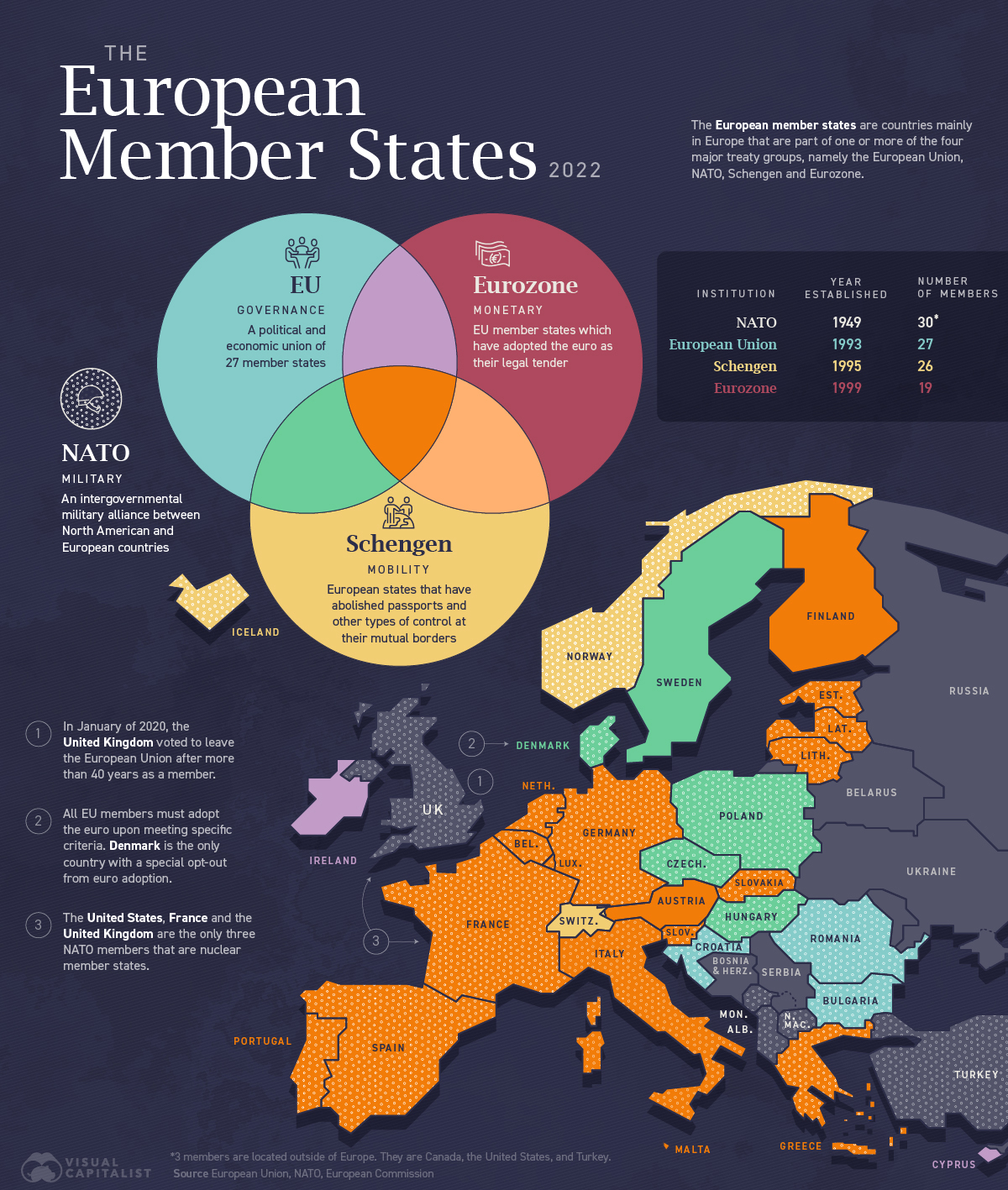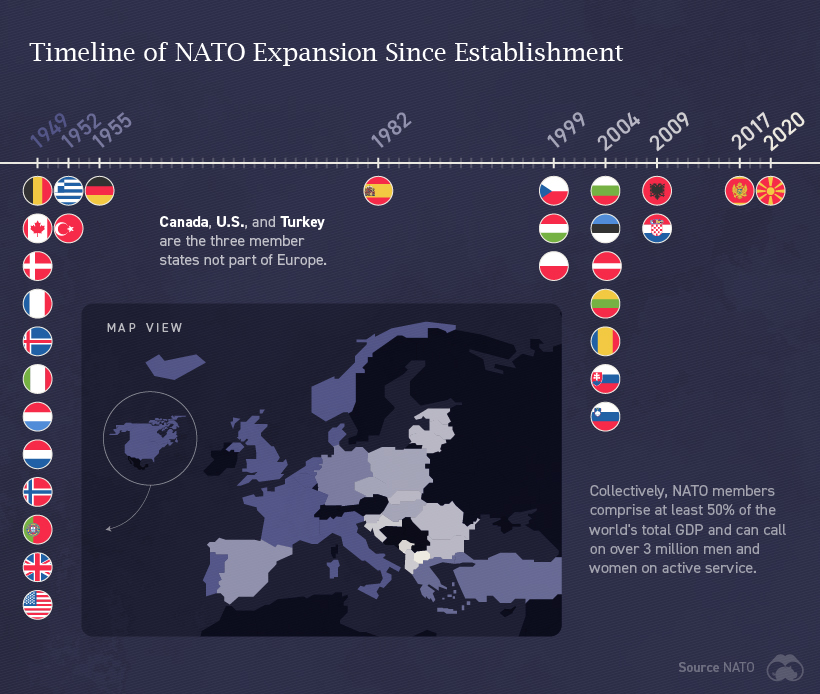
Can I share this graphic?Yes. Visualizations are free to share and post in their original form across the web—even for publishers. Please link back to this page and attribute Visual Capitalist.
When do I need a license?Licenses are required for some commercial uses, translations, or layout modifications. You can even whitelabel our visualizations. Explore your options.
Interested in this piece?Click here to license this visualization.
▼ Use This Visualizationa.bg-showmore-plg-link:hover,a.bg-showmore-plg-link:active,a.bg-showmore-plg-link:focus{color:#0071bb;}
Who are Europe’s Member States?
With Ukraine’s recent bid to join the European Union (EU), the current status of Europe’s member states is back in the fray.
The European member states are countries mainly in Europe, and three outside, that are part of one or more of the four major treaty groups, namely the European Union (EU), NATO, Schengen, and eurozone.
Each of these institutions governs a different aspect of the region’s infrastructure.
Let’s take a look at each of them.
European Union
The European Union (EU) is a unique economic and political union between 27 European countries.
First created as the European Economic Community in the aftermath of WW2, the organization’s main focus was to foster economic cooperation. The idea was simple: countries that trade with one another and become economically interdependent are more likely to avoid conflict.
Beginning with six countries in 1958, the European Economic Community has since added 21 more countries (the UK left the EU in 2020), with a primary focus on single or internal markets.
Here are the countries that comprise the European Union:
| Number | Countries | Year of Accession |
|---|---|---|
| 1 | Austria | 1995 |
| 2 | Belgium | Founder |
| 3 | Bulgaria | 2007 |
| 4 | Croatia | 2013 |
| 5 | Cyprus | 2004 |
| 6 | Czech Republic | 2004 |
| 7 | Denmark | 1973 |
| 8 | Estonia | 2004 |
| 9 | Finland | 1995 |
| 10 | France | Founder |
| 11 | Germany | Founder |
| 12 | Greece | 1985 |
| 13 | Hungary | 2004 |
| 14 | Ireland | 1973 |
| 15 | Italy | Founder |
| 16 | Latvia | 2004 |
| 17 | Lithuania | 2004 |
| 18 | Luxembourg | Founder |
| 19 | Malta | 2004 |
| 20 | Netherlands | Founder |
| 21 | Poland | 2004 |
| 22 | Portugal | 1986 |
| 23 | Romania | 2007 |
| 24 | Slovakia | 2004 |
| 25 | Slovenia | 2004 |
| 26 | Spain | 1986 |
| 27 | Sweden | 1995 |
What began as a purely economic union has evolved into an organization pioneering the development of many different policy areas. A name change from the European Economic Community to the European Union in 1993 reflected this.
NATO
The North Atlantic Treaty Organization (NATO) exists for the sole purpose of facilitating a political and military alliance between its 30 member countries.
Established in 1949 in response to post-WW2 Soviet aggression, NATO exists for the collective defense and security of the group. Members share few laws and regulations. An attack on one constitutes an attack on all, and member states are obligated to defend one another.
The chronological timeline of NATO’s expansion since its establishment paints a fascinating picture.

As of 2021, NATO officially recognizes three aspiring NATO members: Bosnia and Herzegovina, Georgia, and Ukraine. Ukraine has voiced its desire to join NATO since 2014 but hasn’t met its political and military criteria.
Eurozone
The eurozone is a geographic and economic region that consists of countries that have adopted the euro as their national currency. Approximately 340 million people live in the euro area.
Today, the eurozone consists of 19 countries of the European Union. Here they are:
| Number | Countries | Year of Adoption |
|---|---|---|
| 1 | Austria | 1999 |
| 2 | Belgium | 1999 |
| 3 | Cyprus | 2008 |
| 4 | Estonia | 2011 |
| 5 | Finland | 1999 |
| 6 | France | 1999 |
| 7 | Germany | 1999 |
| 8 | Greece | 2001 |
| 9 | Ireland | 1999 |
| 10 | Italy | 1999 |
| 11 | Latvia | 2014 |
| 12 | Lithuania | 2015 |
| 13 | Luxembourg | 1999 |
| 14 | Malta | 2008 |
| 15 | Netherlands | 1999 |
| 16 | Portugal | 1999 |
| 17 | Slovakia | 2009 |
| 18 | Slovenia | 2007 |
| 19 | Spain | 1999 |
European Union nations that decide to participate in the eurozone must meet a multitude of financial requirements. They include price stability, sound public finances, the durability of convergence, and exchange rate stability.
Not all countries have to adopt the currency, though. For example, Denmark has a special opt-out clause to use its own currency and maintain its financial independence.
Schengen
The Schengen Area comprises 26 European countries that agreed to create common entry and exit requirements to remove the need for internal borders. This allows travellers up to 90 days of visa-free travel to any of the countries in the Schengen Area.
The border-free Schengen Area guarantees free movement to more than 400 million EU citizens, along with non-EU nationals living in the EU or visiting as tourists, exchange students, or for business purposes.
Here’s a list of the 26 countries that are a part of the Schengen Area:
| Number | Countries | Year of Implementation |
|---|---|---|
| 1 | Austria | 1997 |
| 2 | Belgium | 1995 |
| 3 | Czech Republic | 2007 |
| 4 | Denmark | 2001 |
| 5 | Estonia | 2007 |
| 6 | Finland | 2001 |
| 7 | France | 1995 |
| 8 | Germany | 1995 |
| 9 | Greece | 2000 |
| 10 | Hungary | 2007 |
| 11 | Iceland | 2001 |
| 12 | Italy | 1997 |
| 13 | Latvia | 2007 |
| 14 | Liechtenstein | 2011 |
| 15 | Lithuania | 2007 |
| 16 | Luxembourg | 1995 |
| 17 | Malta | 2007 |
| 18 | Netherlands | 1995 |
| 19 | Norway | 2001 |
| 20 | Poland | 2007 |
| 21 | Portugal | 1995 |
| 22 | Slovakia | 2007 |
| 23 | Slovenia | 2007 |
| 24 | Spain | 1995 |
| 25 | Sweden | 2001 |
| 26 | Switzerland | 2008 |
Monaco, Vatican City, and San Marino also have open borders with Schengen area countries even though they aren’t part of the treaty.
The post A Visual Guide to Europe’s Member States appeared first on Visual Capitalist.